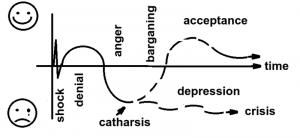2.5.4 The Stages of Grief
As hospice patients are dealing with the prospect of their own death, grief is a daily reality for clients, their loved ones, and you, the care provider. Palliative care patients who are not terminally ill can also deal with grief after a very serious diagnosis.
The Kübler-Ross Model is a sequence that models the typical progression through grief from the point that the bad news is received and understood. The following simple diagram represents these stages in the order that they are experienced:

As you can see in the diagram above, individuals can take one of two paths as they process the bad news they have received. All subjects experience the initial shock, where the bad news is received and emotions run haywire. Then, they all experience denial, where a person avoids thinking about the bad news and is falsely happy, and anger, where a person’s mood declines. But, at the moment of catharsis, a person can either achieve acceptance and return to a happy state, or spiral into depression and end up in crisis.
Practice Makes Perfect
Check your understanding of the different stages in the Kübler-Ross Model by completing this short matching exercise:
In palliative and hospice care settings, supports for families are important, and you may be called upon to offer a listening ear, compassion and support. Remember, you are not a trained grief counsellor, so offer what supports you can, but do pay attention to situations which may require additional resources or skillsets than you have to give.
Key Takeaway
One very helpful Canadian resource for anyone who is grieving is mygrief.ca. Check it out, and perhaps it will be a helpful resource to share with clients and their families in the future.
As a care provider, it can be easy to pick up others’ grief and to bear it as your own. You care about your clients, and you will feel grief as their health declines. But, since you must continue doing your job and avoid burnout, it is critical that you learn how to process your grief and move forward.
Watch “Coping with Patient Death | Breakroom Chat” to hear a frank discussion about what it is like to experience a client’s death, and how best to cope with the grief:
Download a video transcript in Microsoft Word format. Direct link to the video: https://youtu.be/4LPywjOMEUU.
Practice Makes Perfect
If you like, start your own “good things journal” as was discussed in the “Coping with Patient Death” video you just watched. Try writing an entry about a positive experience you have had in health care so far.

